|

|
Talkie Walkie Review of the Binatone MR600 PMR 2 Way Radios
Just prior our 2003 Devon holiday we bought a twin pack
Private Mobile Radio (PMR446) system, often called talkie walkies or 2
way radios. Here's our review...
Also on this page: PMR
website links
Other product reviews | Smartphone | Android Apps | Two Way Radios | Digital Camera | GPS
Sat Nav receiver | DV Camcorder
This review assumes a basic understanding
of the appropriate technology. Reviewed October 2004.
This page should now be considered an archive resource (although the
principles may still apply).
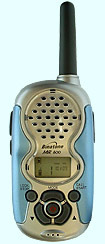 Talkie Walkie radio review, come in
please, over... Talkie Walkie radio review, come in
please, over...
Alpha Brava One to base, receiving you loud and clear, go ahead, over...
We figured carrying a couple of talkie walkie 2 way radios
would help us keep in touch with each other when we sometimes split up
during our tourist visits - and save on mobile phone costs.
The Private Mobile Radio (PMR446) system uses frequencies in the 446
MHz band and allows individuals to communicate over short distances
without the need for a licence and without any contract or call
costs. Eight channels are available and 38 CTCSS codes sub-divide
these channels to provide closed group communication. The radios
have rechargeable batteries which are conveniently charged by dropping
the talkie walkies into a cradle. Operation is by pressing the
Press-To-Talk (PTT) button and a Call Alert tone can be sent (10
available). Voice Operated Transmission (VOX) allows hands free
operation. Transmission range is quoted as up to 3 km (2
miles)... well, we'll see...
On the right. The rounded style of
the talkie walkie 2 way radio and its stubby little aerial.
|
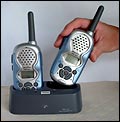
The radios conveniently
slip into a charging pod.
|
Off we go then
We just had time to charge the PMR446 2 way radio
batteries overnight before we were off on our 2003 Devon holiday next day. We
decided to use channel 7, picked a CTCSS code at random and set both
talkie walkies to these. Then we quickly learnt the phonetic
alphabet - Alpha, Bravo, Charlie, Der, er, oh, that's not right, o
well, let's forget the radio babble then!
Although they're often referred to as 2 way radios, in
fact many users can communicate provided all the units are set to the
same channel and CTCSS code. Unlike a mobile phone, only one
person can talk at once, ie one way at a time.
|
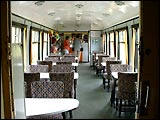 The holiday cottage
was just up the road from the local convenience store and our first use
of the talkie walkies was when Belinda, armed with a radio, received a
call from Mike when he remembered a shopping item (and it wasn't the
beer!). Without the talkies he would have had to use the mobile
phone, or get off the sofa and run down the road - and we can't have
that! Another occasion occurred when Mike 'disappeared' on the The holiday cottage
was just up the road from the local convenience store and our first use
of the talkie walkies was when Belinda, armed with a radio, received a
call from Mike when he remembered a shopping item (and it wasn't the
beer!). Without the talkies he would have had to use the mobile
phone, or get off the sofa and run down the road - and we can't have
that! Another occasion occurred when Mike 'disappeared' on the  South Devon Railway train and
Belinda called him up to ask where her coffee was he'd trotted off to
get. It turned out he'd got the coffee, but then got delayed
yacking to some steam buffs in the dining car! >>> South Devon Railway train and
Belinda called him up to ask where her coffee was he'd trotted off to
get. It turned out he'd got the coffee, but then got delayed
yacking to some steam buffs in the dining car! >>>
<<< On a hot walk round the South West Coast Path from Hope Cove
Belinda took a breather at Thurlestone while Mike carried on towards
Bantham. Here we began to realise shortcomings with the
transmission range, as shortly after rounding the headland contact
became patchy. Sometime later back home we did some range tests...
Above. The talkie walkie signal faded out once
round the headland on the other side of the beach seen above.
Testing the talkie walkies 3 km range
Safely back from holiday we decided to test the actual
distance we could communicate with the 2 way radios. We started
off at our home, Belinda walked towards the village centre (picture
right) while Mike walked in the opposite direction. It wasn't long
before reception got patchy and we lost touch. On our return home
we plotted the distance 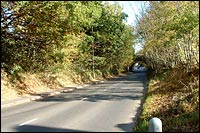 achieved on the map
and it turned out to be barely 1 km, a third of the quoted range.
Now, although built-up we hardly live in the great metropolis so were
rather disappointed with this. But to balance this we also took
the talkie walkies up our local hill on the South Downs, and from the
top we could comfortably hear our local garden centre over 3 kms
away. They use professional PMR446 radios, but we also heard
domestic signals from a similar distance. A check on the Internet
revealed that not all consumer PMR446 talkie walkies are created equal
and some perform better than others, despite government specified
design limitations (power limit, no 'gain' aerial, etc). achieved on the map
and it turned out to be barely 1 km, a third of the quoted range.
Now, although built-up we hardly live in the great metropolis so were
rather disappointed with this. But to balance this we also took
the talkie walkies up our local hill on the South Downs, and from the
top we could comfortably hear our local garden centre over 3 kms
away. They use professional PMR446 radios, but we also heard
domestic signals from a similar distance. A check on the Internet
revealed that not all consumer PMR446 talkie walkies are created equal
and some perform better than others, despite government specified
design limitations (power limit, no 'gain' aerial, etc).
Testing other features of the 2 way radios
The talkie walkies have a VOX feature that starts
transmitting once it detects your voice. Three levels of
sensitivity can be set and we tried this in the car using the provided
hands free ear/mic cable. Ambient noise caused transmission on
the most sensitive setting, while the two lower settings required
shouting to make it send. Best forget the VOX function
then! Then again, it could function well as a baby alarm - just
need the baby now.
There's a scanning feature on the talkie walkie radios that
continually scans all eight channels for a signal, and the LCD display
illuminates briefly when a button is pressed. The display
indicates when transmission or reception is taking place, battery
charge state, channel, CTCSS code and volume level.
|
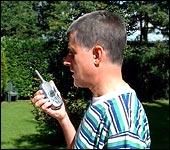
|
We found a slight delay apparent when pressing the PTT
and when using the CTCSS codes which resulted in missing the first few
words of a message. But we quickly adapted to this by delaying
speaking for a moment after hitting the PTT. Speech quality was
'loud and clear', except when talking close into the mic, then it
sounded 'breathy'. A flimsy belt clip is provided, but we don't
trust this so we purchased a couple of suitable soft carry cases which
allows the talkie walkies to be carried over the shoulder.
<< The talkie walkie fits
comfortably in the hand with the required controls falling readily to,
er, hand.
|
 Using
a CTCSS code isn't compulsory, in which case you may hear other users
on the same channel. However, using this code doesn't ensure
communication privacy and can cause reception to cut-out if a stronger
transmission is in operation on the same channel. The LCD display
indicates when a signal is being received on a channel, irrespective of
any CTCSS code and a press of the monitor button will make audible all
communication on that channel. We've seen some misleading
advertising indicating '304 channels' - gained by multiplying the 8
channels by the 38 CTCSS codes. Ohhh, naughty! At the end
of the day there's still only 8 channels! Using
a CTCSS code isn't compulsory, in which case you may hear other users
on the same channel. However, using this code doesn't ensure
communication privacy and can cause reception to cut-out if a stronger
transmission is in operation on the same channel. The LCD display
indicates when a signal is being received on a channel, irrespective of
any CTCSS code and a press of the monitor button will make audible all
communication on that channel. We've seen some misleading
advertising indicating '304 channels' - gained by multiplying the 8
channels by the 38 CTCSS codes. Ohhh, naughty! At the end
of the day there's still only 8 channels!
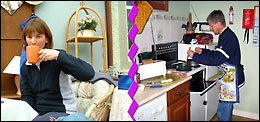 In the following year on our 2004 Scotland holiday we found the
talkies to be a godsend in the cottage. The kitchen/conservatory
distance was beyond shouting range, so the 2 way radios were ideal
for Belinda to order a tea/wine/cider while Mike was slaving away in
the kitchen preparing the evening meal! A slight irritation is
the impossibility of standing the radios vertically owing to the
rounded styling and one thing we noticed after a year's use was minor
dust build-up behind the plastic over the LCD display. In the following year on our 2004 Scotland holiday we found the
talkies to be a godsend in the cottage. The kitchen/conservatory
distance was beyond shouting range, so the 2 way radios were ideal
for Belinda to order a tea/wine/cider while Mike was slaving away in
the kitchen preparing the evening meal! A slight irritation is
the impossibility of standing the radios vertically owing to the
rounded styling and one thing we noticed after a year's use was minor
dust build-up behind the plastic over the LCD display.
Other uses we found for the talkie walkie radios include:
- Belinda reels in Mike from washing the car when dinner's
ready (very domestic!)
- When shopping Belinda prefers the clothes shops while Mike
technology ones (or the pub). We call each other when it's time
to meet back up
- Belinda tends to call Mike up from the train station to
get the kettle on and have a cup of tea ready after returning from a
hard day's shopping
- Keeping an ear out for fellow Geocachers when Geocaching
- Placing a radio in the cat's basket and making cat sounds
through it really winds up the cat up!
Other suggestions:
- Keeping in touch at large events, eg county shows, party
in the park, football matches, firework displays, open air concerts, on
the crowded beach, driving in convoy
- Call your mates at the pub to get a pint in just before
you arrive
- Wake up your partner with the Call Alert tone when he/she
falls asleep in the bath
- Baby alarm
Any other points
The 2 way radios have a button lock, eg. to prevent
inadvertent channel change, and the key tones can be turned off.
An auto power off feature to save battery power if not used for a while
is available as is a stopwatch timer. It's possible to use dry
cells (or higher capacity rechargeable) in place of the pack provided
as the talkie walkies take four standard sized 'AAA' cells. In
this case it wouldn't be possible to use the drop in charger pod.
|
Good Points...
|
Bad Points...
|
- No call costs or subscription
- Handy communication method
- Speech quality
- Drop in charger convenience
|
- Can't stand it up vertically
- Limited range
- Dust build behind LCD window
- VOX sensitivity
|
Overall conclusions
The Binatone MR600 two way radios (or three way, four way or however
many you wish) are a very useful communication method over short
distances. However, that distance is severely limited by the low
power and aerial constraints governed by the PMR446 licence-free
regulations. While our Binatone talkie walkies are adequate,
there are undoubtedly better units around and if in the market again
we'd do some more research before purchase. That's about it,
Alpha Brava One over and out!
It's 2010 - so no updates in six
years?
Er, no. We've not seen a need to update this review as the talkie
walkies have largely continued to work as tested since our
review. If pushed we could report that the dust build-up has
continued behind the display, and the batteries don't last quite as
long between charges, but that's about it! No failures and
nothing's fallen off.
However, our Binatone MR600 talkie walkies have become a bit
battered in use so in early 2010 we looked to see what's available to
replace them... ...and came up with the Binatone Action 950 two way radios -
see our review.
You can't find the Binatone website
anymore as their business model has changed.
PMR446 related website resources (last checked 2021):
Review Centre - two way radio reviews.
Ofcom - PMR446 Information
Sheet (PDF).
TelecomsAdvice - Using PMR for businesses.
Please inform us if you find deadlinks above.
© micbinks 2004. Please ask permission if you
wish to reproduce any of our content.
|
